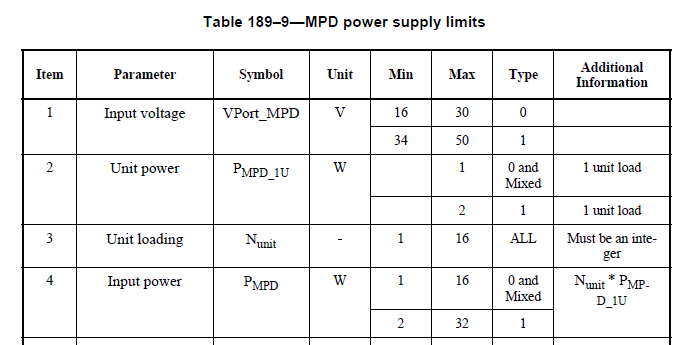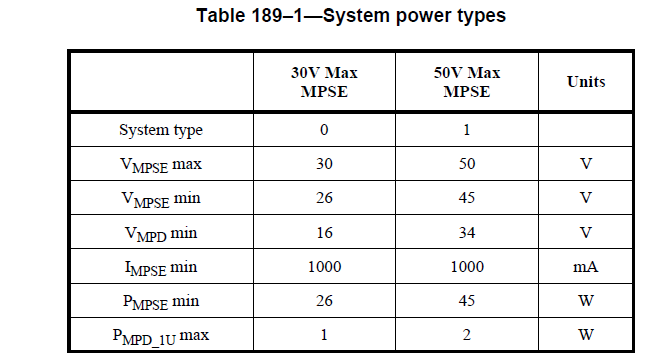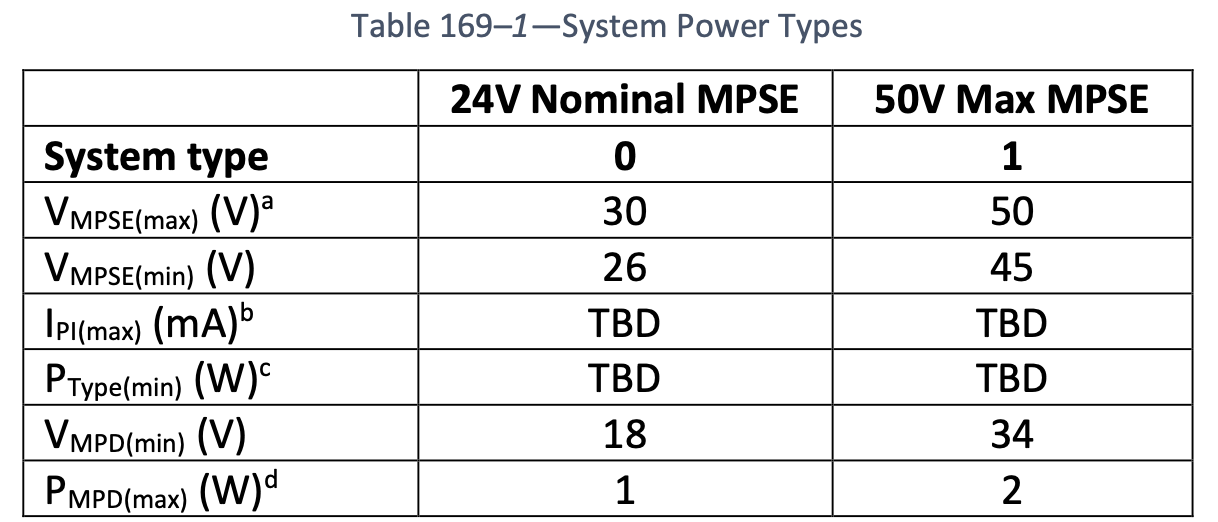Thank you for your clarification.
The design burden I am referring is about the auxiliary power supply. If I am designing an industrial control system, it is very likely I already have a 24V bus feeds digital
I/O, relay, panel, etc… It would be much easier if I can tap MPSE into that 24V power supply. You are correct that -10% tolerance seems too arbitrary and maybe too conservative, but we are still talking about 24V – x%(we can debate what x should be), not
26V, which will require additional circuits to boost voltage. Keep in mind that x% is not only just for the tolerance, but also for the voltage drop in the circuit need to provide function and protection.
I am not sure about my mistake on the MPD power. The number is listed in table 189-9

So if I were a design engineer to implement this, I would have checked my total load requirement. If it is 16W, I would choose type 0. if I need just 1 W more, I would have
to bump up to type 1. So increasing VMPSE(min), therefore higher
guaranteed MPSE power does not really help me. Even if VMPSE(min) is 26V and MPSE and MPD are next to each other so 0 voltage drop between them, technically
MPD can pull full 26W(26V x 1A) from MPSE, but I still can not do that without change on table 189-9 at the same time, because my design is limited by PMPD in table 189-9, not PMPSE in table 189-1. Did I misunderstand anything here?
General
From: Chad Jones (cmjones) <cmjones@xxxxxxxxx>
Sent: Wednesday, January 8, 2025 11:56 AM
To: Zach Pan <zach.pan@xxxxxx>; STDS-802-3-SPMD@xxxxxxxxxxxxxxxxx
Subject: Re: D2.0 comments 297 and 269
[External email: Use caution with links and attachments]
Zach, discussion here is encouraged, thanks for your reply.
You are correct in that I left out the power lost to the cable in my rough estimates for MPD power. That additional loss further exacerbates problem, as incremental power is allocated to the mixing segment.
This means the numbers in my previous email are best case numbers…
You are mistaken to use the min MPD voltage to calculate MPD power. I was also careful to state I was talking about guaranteed MPSE power. The Min MPD voltage is what the last MPD on the mixing segment might
see, but not what every MPD will see. It hurts the head at times to think about this as the number of elements get hard to juggle. I’ve assembled a spreadsheet to help better estimate what a system might get per PD, I expect to write an annex at some point
and post that spreadsheet on the 802.3 site which 802.3 customers could use to help better engineer their system. It’s part of a bigger issue I have with the draft and unit loads, but that’s a whole other rathole that I will avoid right now.
Restricting the minimum MPSE voltage isn’t a burden on MPDs or MPSEs. It’s a burden on the power supply one might use to power the MPSE. My recollection of the discussion over time was that it’s a small burden
to insist the MPSE supply has a tighter “minus” tolerance than to cripple every installation by making the lower limit artificially low. What’s the reality that you’ll encounter a “24 V system” at 21.6 volts?
Regards,
Chad Jones
Principal Engineer, Cisco Systems
Executive Secretary, IEEE 802.3 Working Group
Chair, IEEE P802.3da Task Force
Principal, NFPA 70 CMP3
To unsubscribe from the STDS-802-3-SPMD list, click the following link: https://listserv.ieee.org/cgi-bin/wa?SUBED1=STDS-802-3-SPMD&A=1


